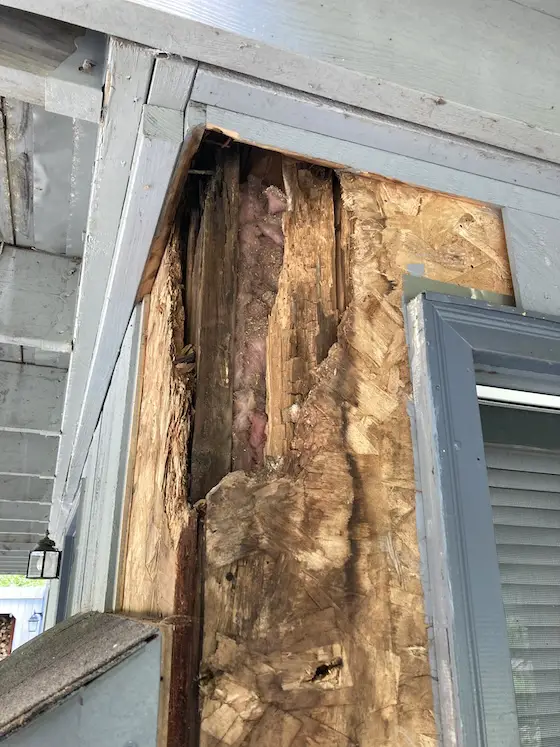Bad Deck Flashing Causes Rot

This is severe wood rot that has compromised the corner of this home. Poor workmanship is the cause. The carpenter installed the flashing wrong. Copyright 2024 Tim Carter
Bad Deck Flashing Causes Rot
Ed, my golf league partner, asked me a few days ago if there was a product to fix some wood rot he had discovered at his home. You may be battling wood rot too. In your case it might be interior wall studs or floor joists that get wet from a plumbing leak. Or, you may have some decorative exterior wood trim that’s falling apart. This happened to my very good friend Steve out in California. Allow untreated wood to stay wet for long periods of time and you’re going to experience wood rot.
I told Ed that there was an amazing wood epoxy and a wood hardener that he could use assuming the rot was minimal. I clarified that he had to send me a few photos of the problem the next day.
When the photos arrived, I immediately texted Ed saying, “This is serious. I need to stop by.” Ninety minutes later I was at Ed’s home talking with him and his lovely wife. I visit homeowners quite frequently as many hire me to consult with them. They all want to know the same things:
- what caused their problem
- what is the best way to fix it
The wood rot was concentrated at a corner of Ed’s house under a deck. I had asked him to remove the few decking boards above the rot. He had already removed the wood siding, which exposed the rot.
Much of the oriented strand board (OSB) at the corner had disintegrated. The two 2x6s that made up the house corner were rotted out completely. The water damage had been happening for years. It was not going to be an easy repair because the rot extended up behind the exterior deck ledger boards.
An Inferior L-Shaped Flashing
An inferior flashing on top of the deck ledger was the root cause of the leak that caused the wood rot. But the builder made another serious mistake. There was no water barrier at all on the exterior walls. The OSB was just covered with shiplap wood siding.
No Water Barrier Covering the OSB!
If the builder had installed a water barrier correctly, there’s a good chance the flashing leak would have only rotted out the wood siding. But Ed’s OSB and the wood studs behind it were doomed.
I had discovered the same thing at my own home years ago. Many builders in New Hampshire, in my opinion based on visiting hundreds of defective homes, do very poor work. Most have no understanding of water’s surface tension.
Mimic Mother Nature to Stop Rot
You can prevent wood rot when building a home if you just mimic Mother Nature. Have you ever given thought to how wildlife of all types avoids hypothermia? I see ducks and loons bobbing around happy as can be in the lake next to my home when the water temperature is 34 F and it’s raining.
The feathers on ducks, loons, eagles, hawks, and just about every other bird are oriented to shed water. One feather overlaps the feather(s) below it. Roofers do this same thing with the shingles on your roof.
Carpenters need to do the same thing with the products used on the exterior of your home. It Ed’s case, and that of thousands of other homes no doubt, this overlap principle was not followed when it came time to install the deck ledger board against the house.
You Need a Special Flashing Detail
A waterproof membrane needs to be installed over the wood sheathing behind the ledger board. The wood siding is then installed up to the height of the top of where the ledger board will be. The ledger is then installed over the top of the siding.
Once the ledger is installed, a piece of rubberized adhesive flashing can be attached to the waterproof membrane. This flexible flashing should extend over the top of the ledger board and then down the face of the ledger about 3/4 inch. A copper flashing should be installed over this rubberized flashing. This flashing needs to be bent over the top of the ledger board and extend out over the deck ledger board. Ed’s builder/carpenter did this but he let it stop at the outer edge of the ledger board.
Each time it rained, the water went to the end of the flashing and then traveled backwards under the flashing. This is natural and is caused by the surface tension of water.
What should have happened is the flashing should have been 3/4-inch longer and then bent down and over the face of the ledger board. The last quarter inch should have been bent out at a 45-degree angle so the water would form droplets and fall to the ground below the deck.
The deck joists need to have a small 45-degree angled fire cut made at the top so the top of the joist doesn’t touch the flashing. This detail is one of the many things that have transitioned from history to legend to myth just as J.R.R. Tolkien said about the ring.
I created a full-color illustration of this flashing detail that you can purchase from my website.
Column 1569